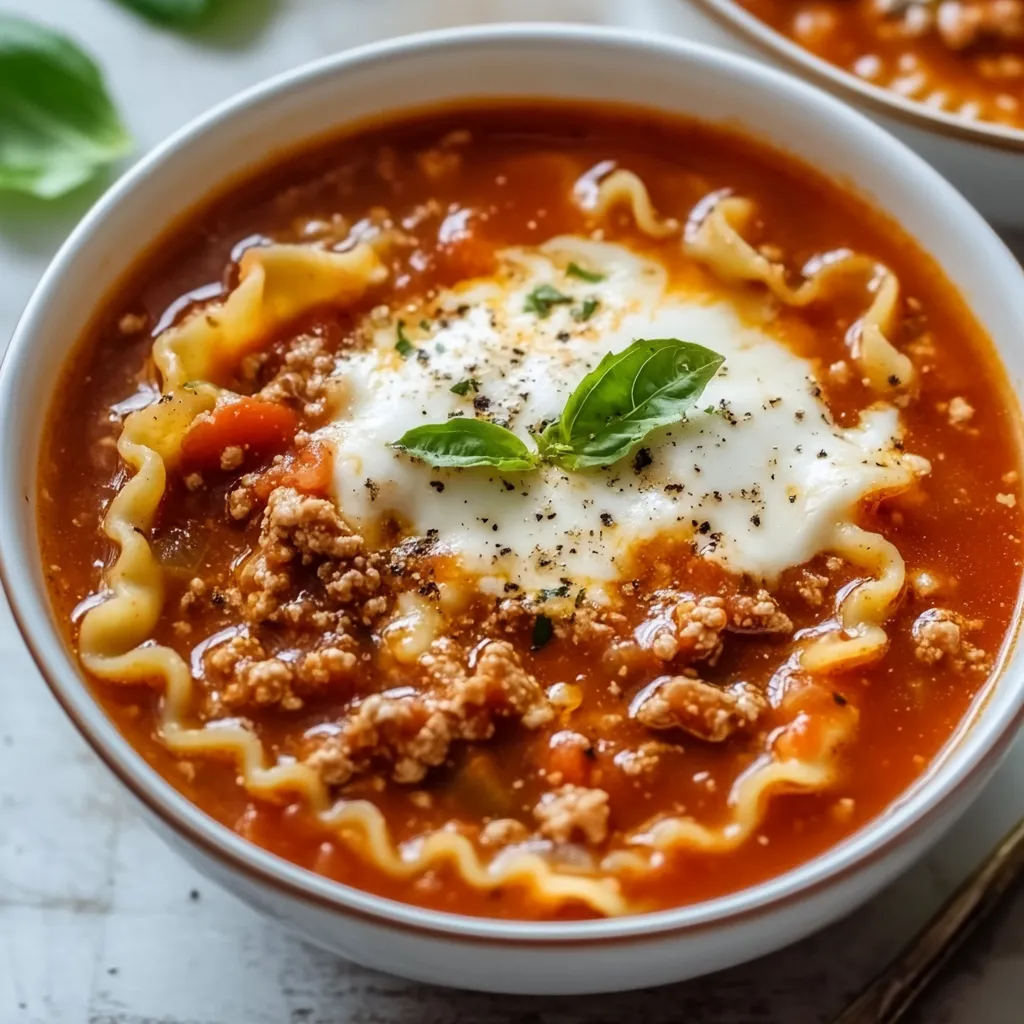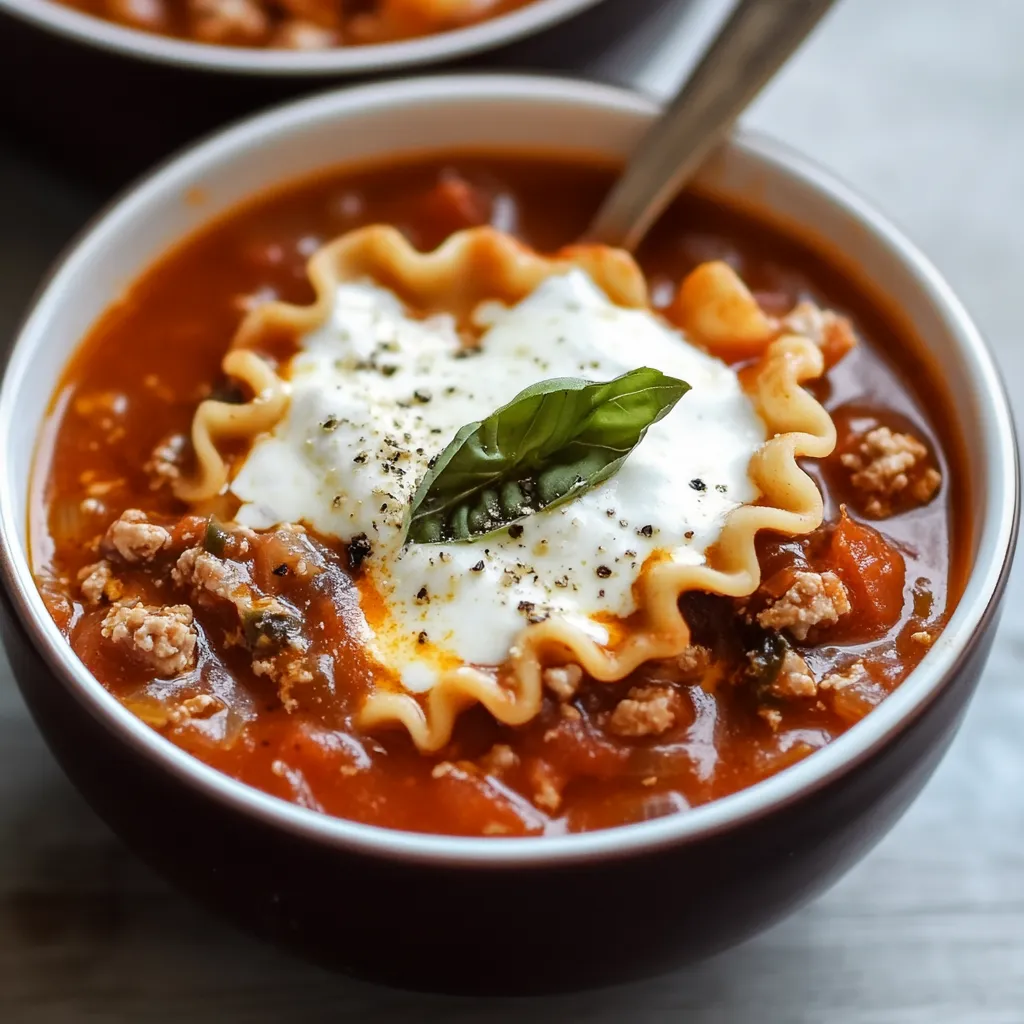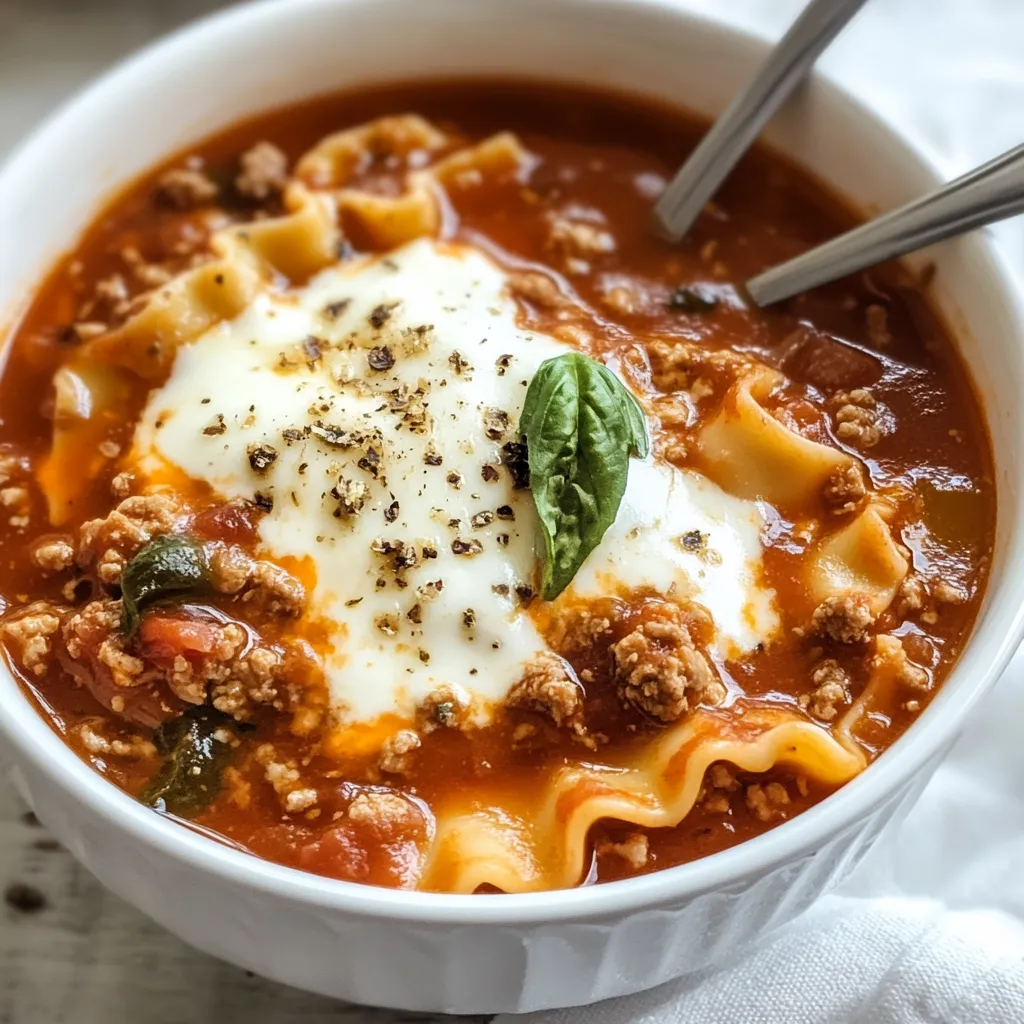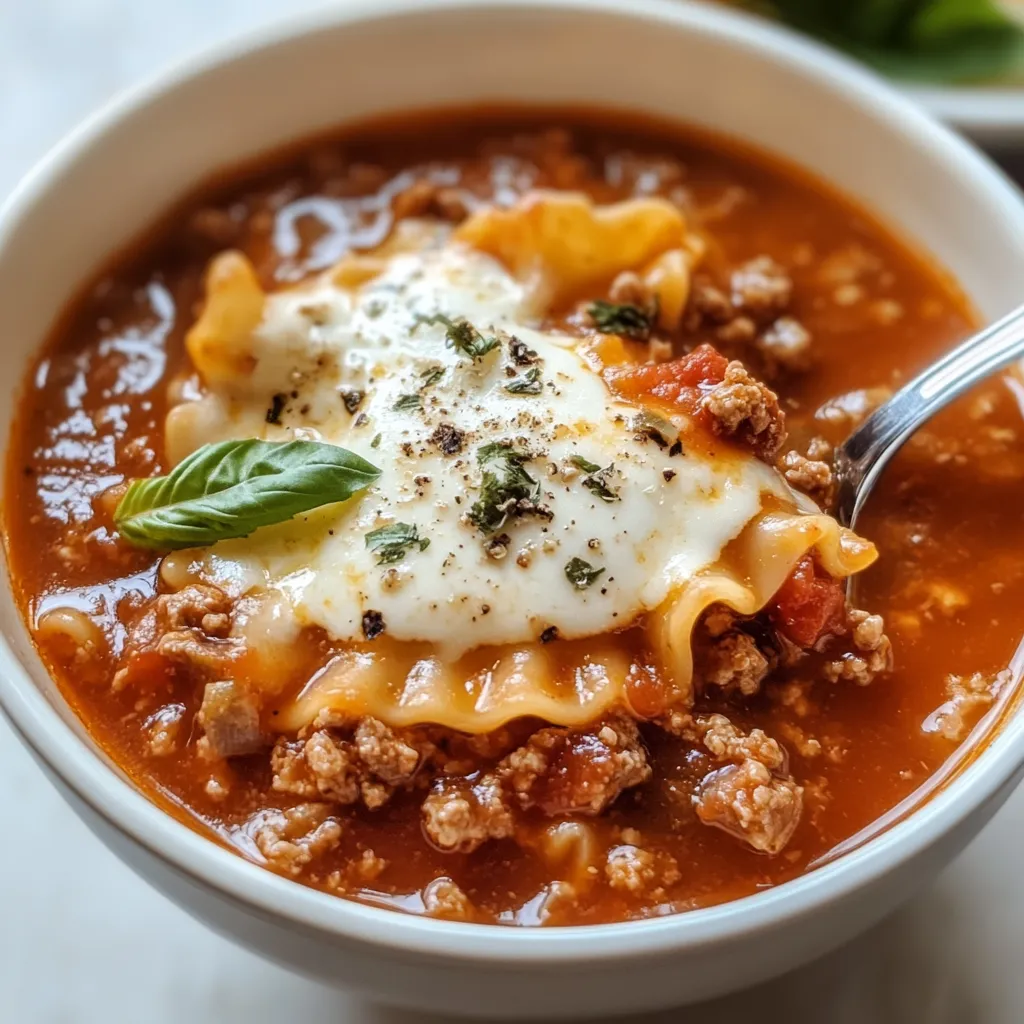
Lasagna soup combines all the comforting flavors of classic lasagna in a warm, hearty soup. It’s a popular recipe because it takes the essence of a beloved dish and simplifies it into an easy, weeknight-friendly meal. The rich combination of meat, tomatoes, and cheese brings a sense of comfort, while the soup format allows for quicker preparation and a lighter, yet satisfying, dish.
One of the key reasons this recipe stands out is its simplicity. Unlike traditional lasagna, which requires careful layering and baking, lasagna soup is a one-pot wonder. It delivers the same indulgent flavors but without the time-consuming process. Whether you’re a novice cook or an experienced chef, this recipe fits perfectly into busy schedules without compromising taste. Moreover, by using broken lasagna noodles, there’s no need to worry about perfectly layering pasta sheets.
Lasagna soup is also highly customizable. You can adjust the level of spice, change the type of protein, or even swap in vegetables for a vegetarian version. If you’re looking to simplify mealtime, this recipe is a great way to enjoy Italian flavors without spending hours in the kitchen. For tips on achieving the perfect pasta texture, check out cooking pasta to perfection and enhance your lasagna soup game with ease.
Ingredients Breakdown
Ground Beef or Italian Sausage
Both ground beef and Italian sausage work wonderfully as the base protein in lasagna soup, but each offers different benefits:
- Ground Beef: Provides a leaner option, making the soup lighter in calories.
- Italian Sausage: Offers a richer, spicier flavor, especially when using sausage with herbs and spices.
Choosing between the two depends on personal preference. If you prefer a mild base, opt for ground beef. For those who love a bit of kick, Italian sausage brings an extra depth of flavor.
Onions, Garlic, and Herbs
The onion and garlic are essential for building the aromatic base of the soup. Sautéing them ensures that the soup is infused with rich, savory flavors. Adding dried oregano and basil further elevates the Italian essence of the dish, while a sprinkle of red pepper flakes offers a subtle heat.
Tomato and Beef Broth
The crushed tomatoes provide a tangy, robust backbone to the soup, while the beef broth adds depth and richness. Using a high-quality broth is essential for balancing the flavors of the soup. It ties everything together, allowing the meat, pasta, and cheese to blend harmoniously.
- Crushed tomatoes add a subtle sweetness and acidity.
- Beef broth gives the soup a hearty, full-bodied flavor that complements the meat.
Pasta Choice
For this recipe, broken lasagna noodles are the ideal choice because they mimic the texture and look of traditional lasagna but in soup form. They’re easy to cook and don’t require the delicate handling that full lasagna sheets need.
If lasagna noodles aren’t available, other pasta options like penne, fusilli, or even elbow macaroni can work well in the soup. These shapes are sturdy and won’t get mushy in the broth.
Cheese Selection
The finishing touch in lasagna soup comes from a combination of ricotta and mozzarella cheeses:
Subscribe to Creatives Cookery!
Get updates on the latest posts and more from Creatives Cookery straight to your inbox.SubscribeI consent to receiving emails and personalized ads.
- Ricotta cheese adds a creamy, rich texture that mimics the filling found in traditional lasagna.
- Mozzarella cheese, melted on top, gives that gooey, stringy texture we all love in lasagna.
Both cheeses play crucial roles in adding richness and authenticity to the soup. The mozzarella melts perfectly over the soup, while ricotta blends in smoothly, giving every bite a velvety mouthfeel.
By carefully selecting these ingredients and following this recipe, you can enjoy all the flavors of lasagna in a fraction of the time!
Step-by-Step Cooking Instructions

1. Browning the Meat
To start, heat a large pot or Dutch oven over medium heat. Add 1 pound of ground beef or Italian sausage and break it up with a spatula. Let the meat cook without moving it for a few minutes to develop a deep brown color, which will add richness to the soup. Stir occasionally, allowing all sides of the meat to brown evenly. If there is excess fat after browning, carefully drain it off to prevent the soup from becoming greasy.
Tip: For the best flavor, avoid stirring the meat too often in the beginning. Let it brown fully before breaking it up, as this caramelizes the surface and enhances the taste of your soup.
2. Adding the Aromatics
Once the meat is browned, add the chopped onion and minced garlic to the pot. Cook them for about 3-4 minutes, stirring frequently until the onion becomes translucent and soft. The garlic should be fragrant but not burnt. These aromatics create the foundation of flavor for your lasagna soup, adding a savory depth that balances the richness of the meat.
3. Simmering the Soup Base
Next, stir in one can (28 ounces) of crushed tomatoes and 4 cups of beef broth. These ingredients create the liquid base of your soup, infusing it with a rich, tangy flavor. To season, add 1 teaspoon each of dried oregano and dried basil, and if you like a bit of heat, include ½ teaspoon of red pepper flakes. Season with salt and pepper to taste.
Bring the soup to a boil, then reduce the heat and let it simmer for 10-15 minutes. This allows the flavors to meld and deepen, making your soup more robust and flavorful.
4. Cooking the Pasta in the Soup
Add 2 cups of uncooked, broken lasagna noodles to the pot. Cook them in the soup, following the package instructions (usually about 8-10 minutes), until they reach the perfect al dente texture. Stir occasionally to prevent the pasta from sticking to the bottom of the pot.
Tip: Cooking the pasta in the soup allows it to absorb the delicious flavors of the broth, but be careful not to overcook it, as it can become mushy.
5. Incorporating Ricotta
Once the pasta is cooked, remove the pot from the heat and stir in 1 cup of ricotta cheese. Incorporating the ricotta off the heat ensures that the soup stays creamy without becoming gritty. The ricotta will blend into the broth, giving the soup a luxurious, velvety texture.
6. Finishing Touches
Ladle the soup into bowls and top each serving with shredded mozzarella cheese and fresh basil leaves. The heat of the soup will melt the mozzarella, creating a gooey, stringy topping that mimics the best parts of baked lasagna. Garnish with basil to add a fresh, aromatic finish.
Enjoy your easy, comforting lasagna soup—a delicious, one-pot meal perfect for busy nights!
Customizing Your Lasagna Soup

Vegetarian Options
To make a vegetarian lasagna soup, simply omit the ground beef or Italian sausage and replace the meat with hearty vegetables or plant-based protein options. Consider adding:
- Mushrooms: For a meaty texture and rich umami flavor.
- Lentils or chickpeas: For a protein-packed alternative that keeps the soup filling and nutritious.
For an extra flavor boost, sauté the vegetables just as you would with meat, to build a rich base for the soup.
Different Proteins
If you’re looking for a lighter or different protein option, try replacing the traditional ground beef with:
- Ground chicken or ground turkey: These leaner meats reduce the fat content while still providing great flavor.
- Turkey sausage: For those who enjoy the spiciness of Italian sausage but want a lower-fat option, turkey sausage works well.
These proteins can be browned and cooked in the same manner as beef or pork, making the swap seamless.
Subscribe to Creatives Cookery!
Get updates on the latest posts and more from Creatives Cookery straight to your inbox.SubscribeI consent to receiving emails and personalized ads.
Adding More Vegetables
Enhance the nutrition and flavor of your lasagna soup by adding vegetables such as:
- Spinach: Stir in fresh spinach at the end for a boost of vitamins.
- Zucchini or bell peppers: Chop these and add them with the onions and garlic for extra texture.
- Carrots: For a touch of sweetness and additional nutrition.
These vegetables not only make the soup heartier but also provide more texture and color.
Spice Levels
To adjust the spice level, you can:
- Increase or decrease the amount of red pepper flakes.
- Add cayenne pepper for more heat.
- Use mild sausage if you’re looking for less spice or a spicy Italian sausage for extra heat.
These customizations allow you to control the intensity of the spice, catering to your personal preferences.
Serving Suggestions and Storage Tips
Serving Ideas
Lasagna soup pairs perfectly with a few side dishes that complete the meal:
- Garlic bread: Use it to soak up the delicious broth, adding a crispy, buttery contrast.
- Side salad: A simple green salad with a light vinaigrette helps balance the richness of the soup.
This combination makes for a balanced meal that’s both satisfying and easy to prepare.
Storage
Leftover lasagna soup stores well for quick meals later on. Here’s how to handle leftovers:
- Refrigerate: Store in an airtight container in the refrigerator for up to 3-4 days.
- Freeze: To freeze, allow the soup to cool completely and store it in freezer-safe containers for up to 3 months. Be sure to separate the pasta if possible, as it can become mushy when frozen.
To reheat, thaw the soup in the refrigerator overnight and warm it on the stovetop, adding more broth if necessary to thin it out.
Meal Prep Tips
This soup is ideal for meal prep as it can be made ahead of time and even frozen for future meals:
- Make ahead: Prepare the base of the soup in advance, but cook the pasta separately. When reheating, add the pasta to maintain the perfect texture.
- Portion control: Freeze individual servings for easy lunches or quick dinners during the week.
Nutritional Information and Health Tips

Calorie Count
Each serving of lasagna soup contains approximately 380 kcal, which is a reasonable amount for a filling meal. When paired with a balanced diet, this dish can fit well within your daily calorie needs. The protein from the ground beef or Italian sausage, along with the cheese and pasta, provides both energy and satiety, making it a perfect choice for lunch or dinner.
Tip: To keep your meal balanced, consider serving the soup with a light side salad or steamed vegetables to add fiber without significantly increasing the calorie count.
Healthier Substitutions
For those looking to lower the calorie content, here are a few simple substitutions:
- Use lean ground beef or ground turkey instead of traditional sausage or beef.
- Swap regular pasta for whole-grain pasta, which adds fiber and helps keep you full longer.
- Opt for reduced-fat ricotta or low-fat mozzarella to cut down on fat without sacrificing flavor.
Subscribe to Creatives Cookery!
Get updates on the latest posts and more from Creatives Cookery straight to your inbox.SubscribeI consent to receiving emails and personalized ads.
These substitutions can lower the calorie content while maintaining the rich and hearty flavors you love in lasagna soup.
Portion Control
Even though lasagna soup is a comforting, hearty meal, it’s essential to practice mindful eating. Serving smaller portions and pairing the soup with a side of vegetables or salad helps ensure a balanced meal. Using smaller bowls can help manage portion sizes, preventing overeating while still allowing you to enjoy a satisfying dish.
Common Mistakes to Avoid
Overcooking Pasta
One of the most common mistakes in making lasagna soup is overcooking the pasta. To ensure your pasta remains al dente, cook it directly in the soup for 8-10 minutes, checking frequently towards the end of the cooking time. Overcooked pasta can become mushy and lose its texture, so timing is key.
Tip: If you’re preparing the soup in advance, consider cooking the pasta separately and adding it to the soup when you’re ready to serve.
Balancing Flavors
It’s easy for the soup to become too salty or bland, especially when using ingredients like broth and cheese. To avoid this, always taste the soup before adding additional salt. If the soup tastes too salty, balance it out by adding more broth or water, or even a splash of crushed tomatoes for acidity.
Tip: Add salt gradually, and remember that cheeses like mozzarella will also add saltiness.
Cheese Clumping
Incorporating ricotta cheese can sometimes lead to clumping if not done properly. To avoid this, remove the soup from the heat before adding the ricotta. Stir the cheese slowly and thoroughly, allowing it to blend smoothly into the broth for a creamy texture.
Tip: Stirring the ricotta off the heat ensures a silky, lump-free consistency, giving the soup a rich and velvety finish.
FAQs
Can I use different pasta?
Yes, you can definitely use different types of pasta in this recipe. While broken lasagna noodles offer the most authentic lasagna-like experience, you can substitute them with penne, rotini, or even elbow macaroni. Just make sure to adjust the cooking time based on the pasta you choose, ensuring it’s cooked to al dente perfection.
Can this recipe be made in a slow cooker?
Absolutely! To make this lasagna soup in a slow cooker, brown the meat, onions, and garlic in a skillet first, then transfer them to the slow cooker. Add the crushed tomatoes, beef broth, and herbs. Cook on low for 6-8 hours or on high for 3-4 hours. About 30 minutes before serving, add the pasta and continue cooking until it’s al dente. Stir in the ricotta cheese just before serving for the creamiest texture.
What if I don’t have ricotta cheese?
If you don’t have ricotta cheese, you can substitute it with cottage cheese or even cream cheese. Both will add a creamy texture, though the flavor might differ slightly. Another option is to skip the ricotta entirely and focus on using more mozzarella for a cheesier finish.
How can I make this soup gluten-free?
To make this recipe gluten-free, simply use a gluten-free pasta. There are many varieties of gluten-free pasta made from rice, quinoa, or chickpeas that work perfectly in this dish. Make sure to check the cooking time on the pasta package, as gluten-free options often require less time.
How long does lasagna soup last in the fridge?
Lasagna soup can be stored in an airtight container in the fridge for up to 3-4 days. When reheating, you may need to add a little extra broth to loosen the soup, as the pasta will continue to absorb liquid while it sits.
Easy Lasagna Soup Recipe | Quick & Hearty 40-Minute Meal
- Author: Sophia
- Total Time: 40 minutes
- Yield: 6 servings 1x
- Diet: Gluten Free
Print Recipe
Pin Recipe
This Easy Lasagna Soup recipe transforms the classic lasagna into a comforting soup that’s perfect for weeknights. With a flavorful blend of ground beef or Italian sausage, rich tomato broth, and tender pasta, it’s topped off with creamy ricotta and mozzarella cheese for the ultimate comfort food in a bowl. Ready in just 40 minutes!
Ingredients
Scale1x2x3x
- 1 pound ground beef or Italian sausage
- 1 onion, chopped
- 3 cloves garlic, minced
- 1 can (28 ounces) crushed tomatoes
- 4 cups beef broth
- 2 cups uncooked pasta (e.g., lasagna noodles, broken into pieces)
- 1 teaspoon dried oregano
- 1 teaspoon dried basil
- 1/2 teaspoon red pepper flakes (optional)
- Salt and pepper to taste
- 1 cup ricotta cheese
- 1 cup shredded mozzarella cheese
- Fresh basil leaves for garnish
Instructions
- In a large pot or Dutch oven, brown the ground beef or Italian sausage over medium heat. Drain excess fat if necessary.
- Add the chopped onion and minced garlic to the pot, sautéing until the onion becomes translucent.
- Stir in the crushed tomatoes, beef broth, dried oregano, dried basil, red pepper flakes (if using), and season with salt and pepper. Bring to a boil.
- Add the uncooked pasta to the pot and cook according to package instructions until al dente, about 8-10 minutes.
- Remove the pot from heat and stir in the ricotta cheese until well combined.
- Serve the soup hot, topped with shredded mozzarella cheese and fresh basil leaves.



